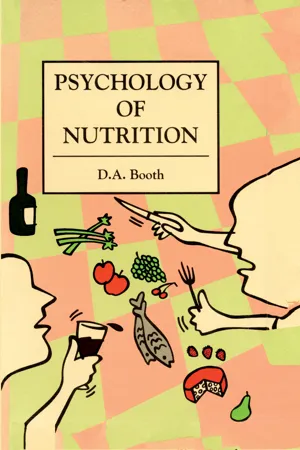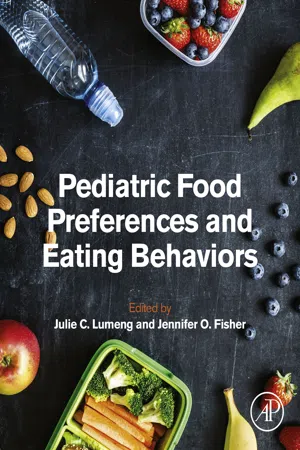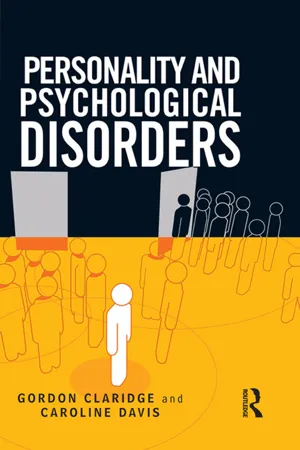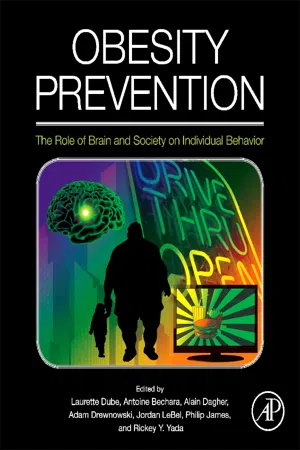Eating Behaviour
Eating behavior refers to the actions and patterns of food consumption, including factors such as hunger, satiety, and food preferences. It encompasses both physiological and psychological aspects, such as the influence of emotions, social norms, and cultural practices on eating habits. Understanding eating behavior is important for addressing issues like overeating, disordered eating, and obesity.
6 Key excerpts on "Eating Behaviour"
- eBook - ePub
- David Booth(Author)
- 2016(Publication Date)
- Taylor & Francis(Publisher)
...Chapter 9 Psychology and the Sciences of Food and Health This chapter places psychological science among the several different sciences and professions that deal with food, nutrition and Eating Behaviour. Psychology of Eating and Drinking Psychology is the science whose defining duty is the systematic empirical study of mental processes that inform the observable behaviour of individual human beings, and indeed of members of other species. Thus, eating and drinking and thoughts and feelings about foodstuffs and beverages should be one of the major areas of research, teaching and application in psychology. Curiously, it is not. What we do overtly and in our heads about food and drink has occupied a far lower proportion of psychologists' time, historically and to the present, than the fraction of waking life that people generally spend doing those things. Worse, the research community that specializes in the study of ingestive behaviour has largely been cut off from the main areas of research into human psychology. For example, fundamental and applied experimental psychology can be considered to be the core of the academic discipline. Commonly called cognitive psychology in recent years, this central mainstream has more than a 150-year history of accumulating research findings and constructing theory, albeit in fits and starts as characteristic of any science. Yet food materials and the concepts involved in their uses have seldom been used in cognitive psychologists' experiments on perception, memory or language...
- eBook - ePub
Companion Encyclopedia of Psychology
Volume One
- Andrew M. Colman, Andrew M. Colman(Authors)
- 2018(Publication Date)
- Routledge(Publisher)
...Indeed, Eating Behaviour represents a particularly intimate form of interaction between organisms and their environments, for it involves consumption of part of the environment, which in turn forms part of the organism and influences the interaction. Moreover, eating is an episodic activity and the processes of appetite control must account for this. Figure 1 The expression of appetite (food intake, temporal patterns, nutrient selection, etc.) reflecting an interaction between internal and external factors The particular patterns of eating observed at any time represent an interaction between two constellations of factors (Blundell, 1979). Figure 1 draws attention to the fact that eating depends not only on the neurochemical and metabolic state of organisms but also on environmental features such as the taste, texture, novelty, accessibility, and choice of food, and on other external features such as the presence of other organisms. This notion of appetite as the consequence of an interaction provides a framework for thinking about appetite in animals as well as in humans. Indeed, Figure 1 emphasizes the way in which food consumption can be broken down into specific components (nutrient selection, micro-structure of behaviour, etc.) so as to diagnose the effects of various factors on the expression of appetite. The pattern of eating provides a sensitive way of assessing the impact of physiological or environmental features (Blundell, 1984). Of course, for humans, the subjective experiences or cognitions surrounding eating can similarly be regarded as being constructed out of physiological signals and the characteristics of the external environment (Blundell, 1981)...
- eBook - ePub
Body Image in Eating Disorders
Clinical Diagnosis and Integrative Approach to Psychological Treatment
- Bernadetta Izydorczyk(Author)
- 2021(Publication Date)
- Routledge(Publisher)
...The body is an important subject of therapeutic influence during treatment, and the treatment itself should be multidirectional and include specialist forms of medical, psychotherapeutic, and dietary interactions adapted to the current stage of the disorder’s development. Psychosocial functions of food versus body image The attitude toward food is defined in the literature as a multidimensional construct regulating cognitive and affective processes as well as behaviors related to eating and nutrition. The affective, cognitive, and behavioral attitude toward food and eating may be positive (adaptive eating habits, eating is a source of pleasure) or negative (disorders of control overeating, eating does not satisfy hunger and biopsychosocial health needs), as in the case of of anorexia, bulimia, and binge eating disorder, or, increasingly often, orthorexia and bigorexia. Attitudes toward food are extremely resistant to change because they are part of the Self structure. Food satisfies biological and mental needs. Through its sociocultural functions, it also determines the individual sense of identity. The part of the personality that determines the sense of identity is the structure of the Self, including the body Self (Izydorczyk, 2015; Krueger, 2002a, 2002b; Sakson-Obada, 2008). Hence, it can be assumed that the specificity of the psychosocial functions of eating and the symbolic meaning of food (nourishment) for the understanding of unconscious internal conflicts of patients with eating disorders are related to the structure of the body Self (body image) as an integral part of the personality structure. This relationship is presented in detail in Chapter 5. Niewiadomska et al. (2005) divided the functions of food into biological, psychological, worldview-related, social, cultural, and economic functions (Fig. 1.2). Figure 1.2 Functions of food (Niewiadomska et al., 2005; Jedzenie. Uzależnienia: fakty i mity [Food. Addictions: Facts and myths], p. 43...
- eBook - ePub
- Julie C. Lumeng, Jennifer O. Fisher(Authors)
- 2018(Publication Date)
- Academic Press(Publisher)
...In the eating domain, making decisions about healthy food choices over convenient food choices requires self-regulation. Planning meals for the week requires self-regulation. Making a decision to stop eating once you feel satisfied requires self-regulation. An individual who eats in the absence of hunger, in the presence of large amounts of palatable foods, exhibits dysregulated eating. As noted previously, self-regulation is largely influenced by the development of skills subsumed by the prefrontal cortex collectively referred to as executive function (EF). Although a universally agreed-upon EF framework does not exist, three commonly referenced EF processes are inhibitory control—the capacity to inhibit a prepotent or automatic thought in favor of a more healthy response, working memory—the ability to keep multiple streams of thought “online” for potential mental manipulation, and cognitive flexibility—the ability to shift cognitive set or attention fluidly from one object to another. Other EF processes, sometimes considered to be higher order EF, include planning, organization, sequencing, and task completion. This chapter will focus on EF and its components that are related to the self-regulation of food intake. Primary attention will be given to dysregulated eating behaviors known to function as behavioral phenotypes of obesity, namely, loss of control (LOC) eating, eating in the absence of hunger (EAH), and binge eating behaviors. We will also describe relations between EF and eating-related appetitive traits. This chapter concludes with a discussion on the implications for prevention and treatment and highlights promising findings from intervention programs designed to improve children's self-regulatory skills. First, let us begin with a discussion on theories that have often been used to understand self-regulation of eating...
- eBook - ePub
- Gordon Claridge, Caroline Davis(Authors)
- 2013(Publication Date)
- Routledge(Publisher)
...In other words, there is a reluctance or inability for them to see things in half measures. Let us consider a nutrition example. If the adolescent has come to believe, for whatever reason, that dietary fat is ‘bad’, this stance becomes completely incompatible with the notion that we all need some fat in our diet for optimal health and well-being. For the reasons described above, it is easy to see why the young are especially gullible consumers of information. They have developed neither sufficient skill nor the cynicism to evaluate the quality of the media’s messages, and they have not had enough experience to know that not everything in print is accurate. Relatively recently, there has been a shift in our thinking about the eating disorders, with a movement away from explanations that rely solely on sociocultural factors, to ones that include a consideration of neurophysiological and genetic influences (Kaye, 1999). Consequently, the prevailing view is that the eating disorders are not only highly complex with respect to their clinical features, but also that multiple factors determine their risk and their severity. Although there is little doubt that environment plays a role in the initiation of dieting, we now believe that it is primarily the psychological vulnerability of the individual that takes normal dieting from something relatively benign, to a life-threatening illness. Before we discuss these individual risk factors in more detail, it is appropriate to review the ways in which clinicians and scientists study the aetiology of eating disorders, and the specific difficulties that these disorders bring to the business of research design and methodology. Research Methodology When trying to determine what premorbid personality factors increase the risk for eating disorders, it is more difficult to untangle cause and effect than it is with most other psychiatric disturbances, simply because the biological abnormalities that define these disorders, viz...
- eBook - ePub
Obesity Prevention
The Role of Brain and Society on Individual Behavior
- Laurette Dube, Antoine Bechara, Alain Dagher, Adam Drewnowski, Jordan LeBel, Philip James, Rickey Y. Yada(Authors)
- 2010(Publication Date)
- Academic Press(Publisher)
...The greater the level of subjective hunger, the more will be eaten; the more that is eaten, the lower the level of hunger (de Castro and Elmore, 1988). To some extent, the influence of hunger appears to be independent of the stomach content. In addition, many humans attempt voluntarily to establish control over their food intake, in a phenomenon labeled dietary restraint. Higher restraint is associated with lower overall intake, smaller meals and lower fat intake (de Castro, 1995). In addition to the social environment, the physical environment also has important effects upon the amounts ingested (Stroebele and de Castro, 2004a). When eating while watching television, people tend to eat more over the day (Stroebele and de Castro, 2004b). In addition, people eat substantially more in restaurants than they do at home or at work (de Castro et al., 1990 ; Stroebele and de Castro, 2004a, 2006). The characteristics of the foods consumed are also important determinants of the amounts ingested. Palatability is a hypothetical construct that stands for the stimulus qualities of a substance that affects its acceptability (Rogers, 1990). The more palatable a food, the greater the amount consumed, with highly palatable meals being 44 percent larger than neutral or unpalatable meals (de Castro et al., 2000). The energy density of the diet ingested is significantly associated with intake (Yao and Roberts, 2001): the more energy per gram of food, the more total energy is ingested in the meal (de Castro, 2004c, 2005). Thus, the social, temporal, psychological and dietary environments have substantial impacts on the amounts ingested in meals and over a day. 22.4 Genes–Environment Interactions Obviously, the control of intake is a complex phenomenon involving a myriad of physiological and environmental variables that independently and interactively influence intake. Classically, genes have been viewed as primarily determining anatomical structure...





